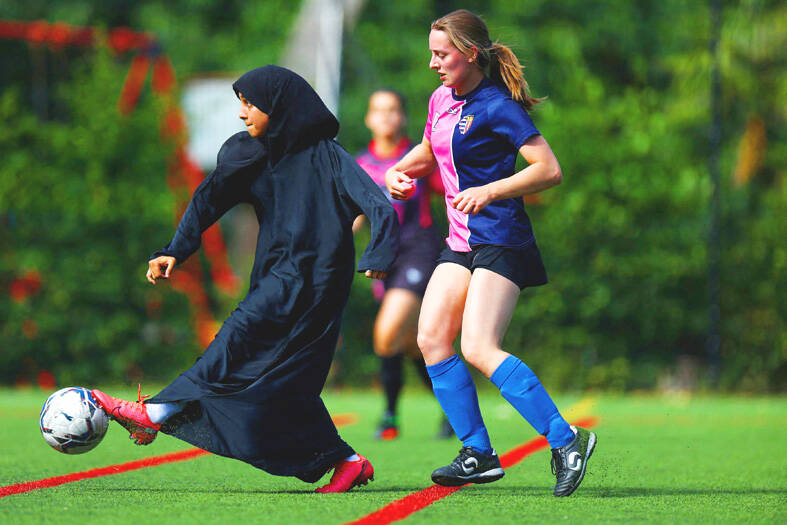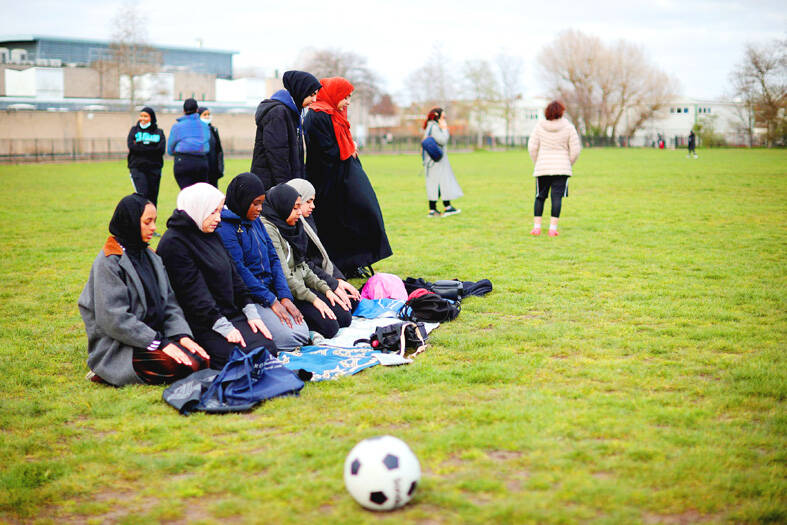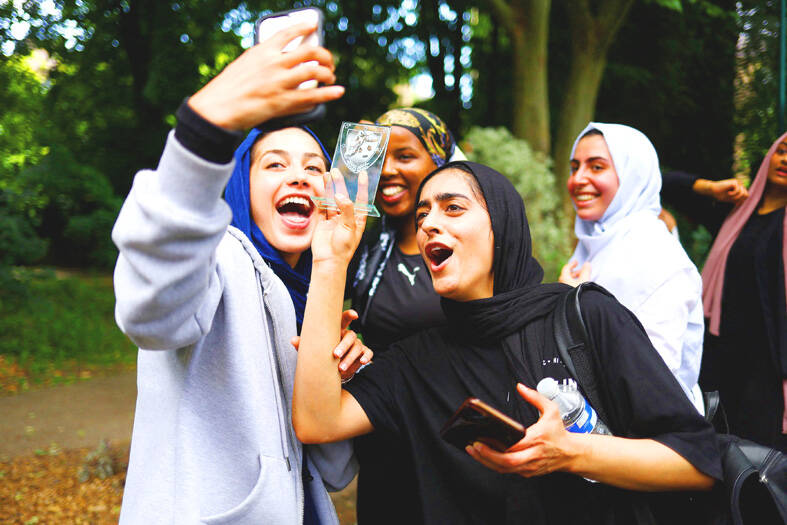On a soccer pitch in a central London park, Sisterhood Football Club — a Muslim women’s team — is making a substitution.
“Your hijab, tuck it in. It can’t get in the way,” a teammate calls out as the replacement player runs on.
Despite the warmth of the afternoon, all of Sisterhood’s players are clothed from head to foot in the club’s all-black colors. Some wear training trousers, almost all of them have hijab headscarves and one is in a body-length abaya robe.

Photo: Reuters
On the sidelines, a squad member unfurls a mat and kneels to pray while her teammates play on against a team led by Brazilian women in bright pink and blue shirts and shorts.
Founded in 2018, Sisterhood has doubled in size to almost 100 players, allowing its members to playing soccer without anyone questioning their dress or asking why they refrain from socializing in a pub after their games.
“It’s a football club for Muslim women to come and feel free and relaxed and be able to play in their attire,” Kamara Davis, 30, said.

Photo: Reuters
She converted to Islam at age 17, and said she felt she would never play soccer again because it seemed incompatible with the religion’s traditional dress.
When she heard about Sisterhood, she jumped at the chance to join.
“Honestly, it just feels so good, it’s like a release. It feels really nice when I am able to shoot the ball with power,” Kamara said.

Photo: Reuters
The club also offers Muslim women a chance to enjoy a break from traditional roles that many say are expected of them.
Fatima Ali, 26, said that some families struggled at first to understand why their young female members wanted to play sports.
“I think a lot of people have approved of it,” she said. “But it is still going to take time. It’s not just a one-step process.”
“Even your brothers might be like: ‘What’s the point of you going all the way from west London to south east,’ but I’ll be like: ‘I enjoy playing, we’ve got a team, this is it, we’ve got a match, we’ve got to go to do this,’” she said.
Yasmin Abdullahi, Sisterhood’s Somali-British founder, recalled the surprise of many fellow female Muslim students when she told them she was playing soccer for University of London’s Goldsmiths’ College when she was a student.
“They could not believe that they were seeing a girl that wears a hijab and saying that she plays football,” said Abdullahi, a 30-year-old fashion model.
She set up the club as a way to reconcile the interest in playing sports among many Muslim women and their adherence to their faith. To underscore the point, Sisterhood’s club badge features the image of a hijab, which was barred by soccer’s world governing body FIFA on safety grounds in 2007. The ban was only relaxed in 2012, with the hijab fully permitted in 2014.
Like many of Sisterhood’s players, Abdullahi is excited about the upcoming World Cup in Qatar.
“What comes with the World Cup is such a beautiful experience, watching matches with your family and your friends,” she said.
Like other club members, Abdullahi drew the contrast between the funding for the England men’s team compared with the national women’s team which won the Women’s European Championship this year for the first time.
“If they’d had equal investment and equal opportunity, where would the women be?” she said.
Sisterhood runs a weekly training session and its first team competes in the Ladies Super Liga for five and seven-a-side teams.
Sara Taleghani said she struggled to reconcile her faith and her hopes of playing sports when she was at school in Ireland.
“I constantly had coaches trying to compromise my religion,” said Taleghani, who works as a social media manager for a public relations agency.
Teachers used to say that her headscarf posed a hazard and they insisted that she wore shorts.
“I think that’s the reason I stopped playing sports at school,” Taleghani said.
For Faezeh Deriss, 23, who recently completed a degree in child psychology, being able to wear what she wants while playing is vital.
“I’ve been to a couple of other football places, but there weren’t any girls who looked like me,” she said. “Other teams I played with, they tried to make me wear shorts. I tried wearing shorts with leggings underneath, but it didn’t feel right.”
There was no such conflict at Sisterhood.
“I feel confident saying to the team that I am just going to go and pray. It’s not an issue,” Deriss said.
Taleghani said she was encouraged to see other Muslim women’s soccer teams, but she had a sense of regret that some players of her generation will never fulfil their potential, given how recently they were given the chance to play.
“If there had been spaces like this when we were growing up, I know a few girls who would have made it as pros,” she said.
For Abdullahi, the most important achievement of the club is the sense of togetherness among its members many of whom have become friends.
“I think the thing that honestly brings tears to my eyes is the fact that we’ve actually built our little community,” Abdullahi said. “The name Sisterhood FC, it’s not by accident like we have literally built a sisterhood.”

Taiwan’s Hsieh Su-wei and partner Jelena Ostapenko of Latvia yesterday advanced to the women’s doubles final at the Australian Open after defeating New Zealand’s Erin Routliffe and Gabriela Dabrowski of Canada 7-6 (7/3), 3-6, 6-3 in their semi-final. Hsieh has won nine Grand Slam doubles titles and has a shot at a 10th tomorrow, when the Latvian-Taiwanese duo are to play Taylor Townsend of the US and Katerina Siniakova of the Czech Republic in the championship match at the A$96.5 million (US$61 million) outdoor hard court tournament at Melbourne Park. Townsend and Siniakova eliminated Russian pair Diana Shnaider and Mirra Andreeva 6-7

The San Francisco Giants signed 18-year-old Taiwanese pitcher Yang Nien-hsi (陽念希) to a contract worth a total of US$500,000 (NT $16.39 million). At a press event in Taipei on Wednesday, Jan. 22, the Giants’ Pacific Rim Area scout Evan Hsueh (薛奕煌) presented Yang with a Giants jersey to celebrate the signing. The deal consisted of a contract worth US$450,000 plus a US$50,000 scholarship bonus. Yang, who stands at 188 centimeters tall and weighs 85 kilograms, is of Indigenous Amis descent. With his fastest pitch clocking in at 150 kilometers per hour, Yang had been on Hsueh’s radar since playing in the HuaNan Cup

Taiwan’s Hsieh Su-wei yesterday advanced to the semi-finals of the women’s doubles at the Australian Open, while Coco Gauff’s dreams of a first women’s singles title in Melbourne were crushed in the quarter-finals by Paula Badosa. World No. 2 Alexander Zverev was ruffled by a stray feather in his men’s singles quarter-final, but he refocused to beat 12th seed Tommy Paul and reach the semi-finals. Third seeds Hsieh and Jelena Ostapenko of Latvia defeated Elena-Gabriela Ruse of Romania and Marta Kostyuk of Ukraine 6-2, 5-7, 7-5 in 2 hours, 20 minutes to advance the semi-finals. Hsieh and Ostapenko converted eight of 14 break

Things are somewhat out of control at the Australian Open this year, and that has only a little to do with the results on the courts. Yes, there were some upsets, including Madison Keys eliminating No. 2 Iga Swiatek in the women’s singles semi-finals on Thursday. It also was the first time since 1990 that three teenagers beat top-10 men’s seeds at a Grand Slam tennis tournament. The loser of one of those matches, Daniil Medvedev, got fined US$76,000 for behaving badly. Last year’s women’s singles runner-up exited in the first round. However, the real fuss is happening elsewhere. The rowdy fans, for one